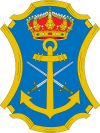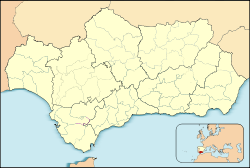- Nerja
-
Nerja — Municipality and town — View from Balcon de Europa in Nerja 
Coat of armsMunicipal location in the province of Málaga Location in Andalusia Location in Spain Coordinates: 36°44′N 3°52′W / 36.733°N 3.867°W Country  Spain
SpainAutonomous community  Andalusia
AndalusiaProvince Málaga Comarca Axarquía - Costa del Sol Government – Mayor José Alberto Armijo Area – Total 85 km2 (32.8 sq mi) Elevation 26 m (85 ft) Population (2009) – Total 21,811 – Density 256.6/km2 (664.6/sq mi) Demonym Nerjeños Time zone CET (UTC+1) – Summer (DST) CEST (UTC+2) Postal code 29870 Website Official website Nerja is a municipality on the Costa del Sol in the province of Málaga, Andalusia, southern Spain. It is on the country's southern Mediterranean coast, about 50 km east of Málaga.
Contents
History
Nerja has a long history, evidenced by the primitive paintings found in its famous Nerja caves, discovered in 1959. These caves are now believed to be just one entrance to a linked series of potholes stretching many miles into the mountains between Nerja and Granada, and which may yet prove to be one of the most extensive unexplored systems in Europe. Visitors to the caves will be able to view the remains of one of the ancient inhabitants of Nerja.
The Romans built here three settlements, including Detunda, of which now large remains can be seen. The area was later taken over by the Arabs in the early 8th century. Under the Moors, the town was known as Narixa, which means "abundant spring", from which the present name derives.
Its agricultural and silk products are said to have been famed throughout the Muslim world and in the markets of Damascus as early as the 10th century.
The Balcón de Europa, a mirador or viewpoint which gives stunning views across the sea, is in the centre of the old town. Its name is popularly believed to have been coined by King Alfonso XII, who visited the area in 1885 following a disastrous earthquake and was captivated by the scene. Local folklore says that he stood upon the site where the Balcón now stands, and said "This is the balcony of Europe". Local archive documents are said to show that its name predated this visit, but this has not prevented the authorities from placing a life-sized (and much photographed) statue of the king standing by the railing.
The Balcón area was originally known as La Batería, a reference to the gun battery which existed there in a fortified tower. This emplacement and a similar tower nearby were destroyed during the Peninsular War. In May 1812, the British vessels Hyacinth, edit] Main sights
- Caves of Nerja
- Balcon of Europe
- The Aqueduct, built in the 19th century
- Baroque Hermitage of las Angustias (17th century)
- Church of El Salvador, in Baroque and Mudéjar style (17th century)
Modern Nerja
In more modern times, sugar cane production has given way to more valuable cash crops, particularly semi-tropical fruits such as mango and papaya and widespread avocado plantations in what is one of the major avocado growing regions in Europe. The sugar cane factory is still on the eastern edge of town, but is now empty.
It is the eastern-most town in the area known as the Axarquía and has an official population of around 22,000 (in 2008) — nearly 30% of which are foreign residents, including around 2,600 British — although the true expatriate population is probably at least twice that. In the summer months, tourism swells the population several times more. The streets are narrow, some one way and some are pedestrians only. Cars line many streets and there are two main car parks to take the overflow.
The town is situated on a fairly steep hill. It has several beaches set in coves beneath cliffs. It is also becoming a significant centre for walkers, thanks to the mountain scenery of the nearby Sierra de Almijara and Sierra Tejeda. The Sierra de Burno overlooks the town. Nerja is also the centre of scuba diving on the Costa del Sol, with the Natural Park of Maro - Cerro Gordo nearby.
The town has five supermarkets, a Lidl and many mini-marts spread around town. Nerja does not have any large stores of the main chains of shops in Spain. Nerja has a small exhibition hall in the High Street and February or March there is a parade of bicycles which attracts a few thousand cyclists, including people of all ages. Also a Carnival parades through the town with people lining the streets.
Public transport
Nerja is not integrated in the Málaga Metropolitan Transport Consortium.
As well as two local bus routes, around town (from the Riú Mónica Hotel), there are buses from the top of the High Street by the Alsa ticket office to Málaga, Caves of Nerja, Frigiliana, Maro, Almuñécar, Vélez-Málaga, Torre del Mar, Granada, Córdoba, Seville, Almería, Motril, and certain months, direct buses to and from Málaga airport.
Twin towns
Cultural references
Nerja has been a source of inspiration for expatriate writers and artists, such as Scottish novelist Joan Lingard, French born author André Launay. Jorge Guillén and Federico García Lorca were longtime visitors and residents of the town[citation needed].
See also
External links
- Official website (Spanish) (English)
- Information about Nerja at andalucia.com
- The Nerja Donkey Sanctuary
- Cueva de Nerja The Nerja Caves (Spanish only)
- What to do in Nerja Festivities calendar
- Malaga Area Metropolitan Transport Consortium
Capitals of provinces 
Port cities Algeciras · Almuñécar · Benalmádena · Chipiona · El Puerto de Santa María · Fuengirola · Marbella · Moguer · Motril · Nerja · San Fernando · Sanlúcar de Barrameda · TorremolinosOther cities Antequera · Aracena · Baeza · Cazorla · Dos Hermanas · Grazalema · Guadix · Jerez de la Frontera · Linares · Ronda · Rota · Santiponce · ÚbedaCategories:- Municipalities in Málaga
- Towns in Spain
- Tourism in Spain
- Populated places in Málaga
Wikimedia Foundation. 2010.







